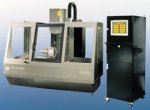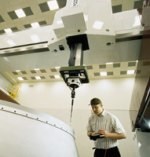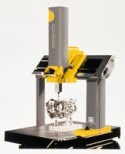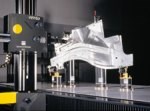Put Coordinate Metrology On The Shop Floor
Integrating CMMs with the machining process employs the power of accurate dimensional data to provide true process control.
Pioneering manufacturers knew that the closer parts came to matching their ideal dimensions, the better they fit together and the better they performed. These people understood that the dimensional information gathered during the measurement of the part could be used as a check on the condition of the process that made it. If a drilled hole was drifting off center, there had to be a reason. Accurate dimensional measurement could point the way toward a solution.
The practical need to accurately measure part dimensions was the catalyst in the development of a host of precision measuring instruments, including calipers and micrometers, height gages and other graduated devices. Of all the tools used to measure part dimensions, the coordinate measuring machine (CMM) is the most capable.
Coordinate measuring machines collect detailed dimensional data by moving a sensing probe along workpiece surfaces. Most CMMs acquire data using a touch trigger probe that contacts individual points on the workpiece. This single-point measurement technique can generally collect data at a maximum rate of about 50 to 60 points per minute, considerably faster than manual measuring instruments.
CMMs As Process Control Tools
What makes coordinate metrology valuable as a process control tool is that it can be used to accurately measure objects of widely varying sizes and geometric configurations, and discern the relationship between features of a workpiece. This flexibility, and the ability of the coordinate measuring operation to be performed quickly when compared with surface plate techniques or fixed gages, means that measurement results can be used to cost effectively refine manufacturing process applications and analyze process trends.
The difficulty with coordinate metrology has been that, as valuable as it is, measurement routines often had to be performed off-line by specially trained technicians who were removed from manufacturing operations. Off-line inspection of this type developed into more of a quality control and quality assurance tool to verify setups or discover non-conforming parts before they were shipped to customers than a true means of process control. With the introduction of statistical process control techniques, however, quality technicians could use the dimensional data gathered by CMMs to study trends in non-conformance and offer that analysis to manufacturing personnel. Manufacturing personnel, in turn, used the information to correct process variations that caused out-of-tolerance conditions. But those process corrections still often occurred after parts had been scrapped or reworked to meet specifications.
Moving CMMs To The Shop Floor
During the last two decades, there has been a trend toward integrating the speed, flexibility and accuracy of the CMM into shopfloor operations. One of the factors driving this trend is the increasing demand for close tolerance production where even the slightest process aberrations can quickly produce useless parts.
Increasingly, measurement is being integrated with the machining process itself. In a transfer line, for example, a measurement station is physically attached to the line. In other cases, measurement integration may be facilitated by some type of transfer mechanism such as a rail guided vehicle, cart, lift-and-carry device or overhead conveyor that transfers workpieces from the machine tool to the CMM for inspection.
The advantage of integrated shopfloor gaging is that, by moving dimensional inspection closer to manufacturing operations, much greater control can be exerted over the process than if the data is gathered in a remote location. Increased control reduces the probability of producing out-of-tolerance parts, meaning less scrap and rework. There are other benefits as well. Integrated shopfloor gaging is most often performed by machine tool operators, which reduces the need for special inspectors. Moreover, shopfloor gaging can be used to compile a historical database of how machines, cutting tools, parts, pallets and fixtures behave during the actual machining process.
Coordinate measuring machines used in these applications have the advantage of being flexible—that is, with a simple software program change, they can be used to inspect workpieces with different dimensions, as well as fixtures, pallets and tooling.
Making Shopfloor Measurement Work
The integration of CMMs on the shop floor has been a technological challenge for CMM manufacturers. The challenge is how to guarantee high accuracy performance at speeds that meet throughput objectives.
The biggest obstacle is temperature variation and the effect it has on the measuring machine and the workpiece. An early solution to this problem was to enclose a traditional CMM to protect it from thermal gradients and to condition the air inside the enclosure to hold the temperature constant. In effect, this approach enclosed the CMM in a laboratory environment. While this approach is a good solution in some circumstances, it does have a drawback in that throughput is sacrificed for accuracy. The enclosure creates some difficulties in workpiece loading and unloading, plus the workpiece has to "soak" at the enclosure temperature before accurate measurements can be taken.
A new approach is to compensate for thermal expansion and thermal distortion errors with a mix of hardware and software solutions that include a web of sensors placed at critical points in the machine structure. The sensors read the temperature on the structure of the machine and a powerful algorithm extrapolates expansion and distortion values from the data. With this data the software is able to compensate for the current thermal state of the machine so that the influence of temperature variations is virtually canceled over a wide range. The result is that on the shop floor, dimensional inspection can be performed with accuracy comparable to that of a lab.
Software Makes Integration Easier
While hardware is important to the functioning of the coordinate measuring machine on the shop floor, software has an equally important role.
CMM software has been refined so that computer programming knowledge or experience is seldom required to run even the most sophisticated programs. Virtually all new CMM software consists of off-the-shelf, menu-driven programs with a comprehensive array of help screens. The result is that software for any particular routine is very easy to use and can be customized to fit individual applications using plain English rather than a specific programming language tied to a complicated operating system. A wide range of software is available. For example, there are programs for statistical process control, sheet metal applications, and turbine blade and gear programs along with a host of others.
Bridging Design And Manufacturing
Next-generation software is being developed to provide the information conduit that genuinely links the design function with manufacturing through the common language of metrology. This new software establishes a bridge between design and manufacturing by means of a common implementation of design tolerances, and between manufacturing and design by providing online and on-demand process information to design engineers.
For example, new software is designed to interface seamlessly with CAD/CAM and off-line inspection systems so that CAD models do not have to be translated when they are downloaded to the inspection system. This gives both the design and manufacturing groups an accurate and consistent analysis of the tolerances that the manufacturing process must maintain for complete and unambiguous assessment of design intent.
Most measurement and inspection software available today is proprietary to the vendor and does not easily interact with other systems. Next generation software, however, will fit everywhere in the manufacturing operation. The operator interface of this new software will be designed to be sensitive to the type of measuring device it is running. It will know if the operator is using manual measuring instrument, such as a caliper, or a full-featured coordinate measuring machine. The software will present only those interactions required for whatever application is being used. This capability will allow users to select the measurement tool most appropriate to the task, maximizing the use of measurement equipment. This approach to software development will enable users to add value to all of their measuring systems by making them more easily integrated into the manufacturing process, rather than isolating them in inspection laboratories.
New software, even today, often features an open architecture, object-oriented approach to development. This means that users will be able to add their own, in-house developed inspection routines and analysis packages to the operating system. Third party developers can also create metrology packages that can be incorporated into the basic software system. The potential for the development of new and unique approaches to measurement and inspection applications is virtually limitless.
Scanning Adds New Dimensions To Shopfloor Measurement
As manufactured components become smaller and tolerances become tighter, more data points must be collected and analyzed to help determine the viability of the manufacturing process. CMMs capable of scanning provide the means of gathering these data points. Scanning is simply a way of automatically collecting data points to accurately define the shape of a workpiece.
Scanning capability was once considered the province of only high technology manufacturers because sophisticated CMMs capable of scanning and the software to run them were expensive and not readily available. Today, however, advances in software and sensor technology have made scanning CMMs considerably more affordable.
New sensors will combine the elements of optics, video and laser technologies into devices that can rapidly scan complex shapes and surfaces, and accurately gather dimensional data. Some of these new sensors can gather up to 20,000 data points per second with extreme accuracy. Combined with these sensors will be powerful mathematical engines that will quickly analyze the billions of bits of dimensional data these systems can generate.
Is the integration of coordinate metrology on the shop floor a concept that is here to stay, or just a passing fancy? It is safe to say that the closer dimensional inspection can be placed to the process, the more valuable the process control capabilities become to the user. The key issues are accuracy and throughput. CMMs coming on the market today are faster, more accurate and less costly than their predecessors of only a few years ago, plus, most are being designed with shopfloor integration in mind. The ultimate value of shopfloor metrology is not only its ability to be integrated into the process, however, but also the link it forges between design intent and manufacturing capability. That is the quantum leap that will make continuous quality improvement an integral part of design, engineering and manufacturing.
Related Content
4 Ways to Establish Machine Accuracy
Understanding all the things that contribute to a machine’s full potential accuracy will inform what to prioritize when fine-tuning the machine.
Read MoreParts and Programs: Setup for Success
Tips for program and work setups that can simplify adjustments and troubleshooting.
Read MoreChoosing the Correct Gage Type for Groove Inspection
Grooves play a critical functional role for seal rings and retainer rings, so good gaging practices are a must.
Read MoreHow to Choose the Right Cut Off When Measuring Roughness
Measurement results for surface finishing parameters can vary depending on the filter parameter (Lc), also known as the cutoff.
Read MoreRead Next
3 Mistakes That Cause CNC Programs to Fail
Despite enhancements to manufacturing technology, there are still issues today that can cause programs to fail. These failures can cause lost time, scrapped parts, damaged machines and even injured operators.
Read MoreThe Cut Scene: The Finer Details of Large-Format Machining
Small details and features can have an outsized impact on large parts, such as Barbco’s collapsible utility drill head.
Read More


















.png;maxWidth=300;quality=90)






.png;maxWidth=300;quality=90)







